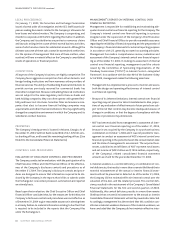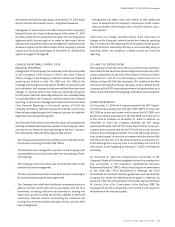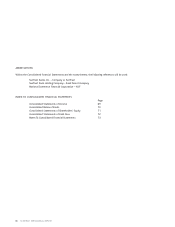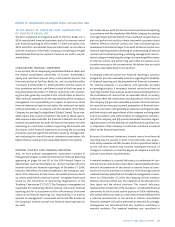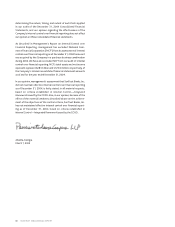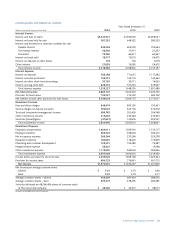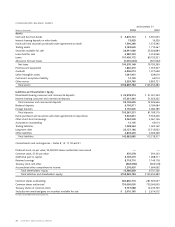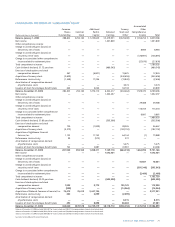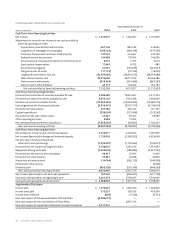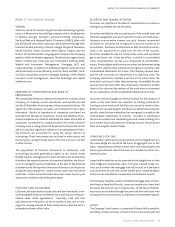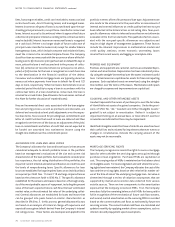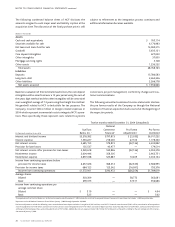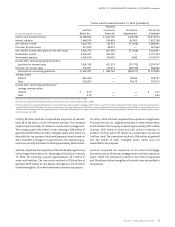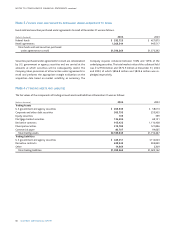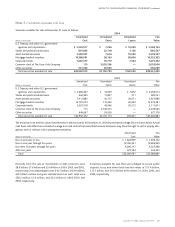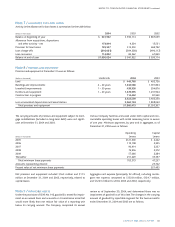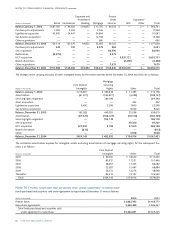SunTrust 2004 Annual Report Download - page 76
Download and view the complete annual report
Please find page 76 of the 2004 SunTrust annual report below. You can navigate through the pages in the report by either clicking on the pages listed below, or by using the keyword search tool below to find specific information within the annual report.
74 SUNTRUST 2004 ANNUAL REPORT
NOTES TO CONSOLIDATED FINANCIAL STATEMENTS continued
lines, factoring receivables, credit card receivables, nonaccrual and
restructured loans, direct financing leases, and leveraged leases.
Interest income on all types of loans is accrued based upon the out-
standing principal amounts, except those classified as nonaccrual
loans. Interest accrual is discontinued when it appears that future
collection of principal or interest according to the contractual terms
may be doubtful. Interest income on nonaccrual loans is recognized
on a cash basis if there is no longer doubt of future collection of
principal. Loans classified as nonaccrual, except for smaller balance
homogeneous loans, which include consumer and residential loans,
meet the criteria to be considered impaired loans.The Company
classifies a loan as nonaccrual with the occurrence of one of the fol-
lowing events: (i) interest or principal has been in default 90 days or
more, unless the loan is well-secured and in the process of collec-
tion; (ii) collection of recorded interest or principal is not antici-
pated; or (iii) income for the loan is recognized on a cash basis due
to the deterioration in the financial condition of the debtor.
Consumer and residential mortgage loans are typically placed on
nonaccrual when payments have been in default for 90 and 125
days or more, respectively. When borrowers demonstrate over an
extended period the ability to repay a loan in accordance with the
contractual terms of a loan classified as nonaccrual, the loan is
returned to accrual status.(See Allowance for Loan Losses section of
this Note for further discussion of impaired loans.)
Fees and incremental direct costs associated with the loan origina-
tion and pricing process, as well as premiums and discounts, are
deferred and amortized as level yield adjustments over the respec-
tive loan terms. Fees received for providing loan commitments and
letter of credit facilities that result in loans are deferred and then
recognized over the term of the loan as an adjustment of the yield.
Fees on commitments and letters of credit that are not expected to
be funded are amortized into noninterest income using the
straight-line method over the commitment period.
ALLOWANCE FOR LOAN AND LEASE LOSSES
The Company’s allowance for loan and lease losses is that amount
considered adequate to absorb probable losses in the portfolio
based on management’s evaluations of the size and current risk
characteristics of the loan portfolio. Such evaluations consider prior
loss experience, the risk rating distribution of the portfolios, the
impact of current internal and external influences on credit loss and
the levels of nonperforming loans. Specific allowances for loan
losses are established for large impaired loans on an individual basis
as required per SFAS Nos. 114 and 118 and large impaired leases
based on the criteria set forth in SFAS No. 5. The specific allowance
established for these loans and leases is based on a thorough analy-
sis of the most probable source of repayment, including the present
value of the loan’s expected future cash flow, the loan’s estimated
market value, or the estimated fair value of the underlying collat-
eral.General allowances are established for loans and leases that
can be grouped into pools based on similar characteristics as
described in SFAS No. 5. In this process, general allowance factors
are based on an analysis of historical charge-off experience and
expected losses given default derived from the Company’s internal
risk rating process. These factors are developed and applied to the
portfolio in terms of line of business and loan type. Adjustments are
also made to the allowance for the pools after an assessment of
internal and external influences on credit quality that have not yet
been reflected in the historical loss or risk rating data. Non-pool-
specific allowances relate to inherent losses that are not otherwise
evaluated in the first two elements.The qualitative factors associ-
ated with the non-pool-specific allowances are subjective and
require a high degree of management judgement. These factors
include the inherent imprecisions in mathematical models and
credit quality statistics, recent economic uncertainty, losses
incurred from recent events, and lagging or incomplete data.
PREMISES AND EQUIPMENT
Premises and equipment are carried at cost less accumulated depre-
ciation and amortization. Depreciation has been calculated prima-
rily using the straight-line method over the assets’ estimated useful
lives. Certain leases are capitalized as assets for financial reporting
purposes. Such capitalized assets are amortized, using the straight-
line method, over the terms of the leases. Maintenance and repairs
are charged to expense and improvements are capitalized.
GOODWILL AND OTHER INTANGIBLE ASSETS
Goodwill represents the excess of purchase price over the fair value
of identifiable net assets of acquired companies. Under the provi-
sions of SFAS No. 142, “Goodwill and Other Intangible Assets,”
goodwill is not subject to amortization. Rather it is subject to
impairment testing on an annual basis, or more often if events or
circumstances indicate that there may be impairment.
Identified intangible assets that have a finite life are amortized over
their useful lives and evaluated for impairment whenever events or
changes in circumstances indicate the carrying amount of the
assets may not be recoverable.
MORTGAGE SERVICING RIGHTS
The Company recognizes as assets the rights to service mortgage
loans for others whether the servicing rights are acquired through
purchase or loan origination. Purchased MSRs are capitalized at
cost. The carrying value of MSRs is maintained on the balance sheet
in intangible assets. For loans originated and sold where the servic-
ing rights have been retained, the Company allocates the cost of the
loan and the servicing rights based on their relative fair market val-
ues at the time of sale of the underlying mortgage loan. Fair value is
determined through a review of valuation assumptions that are
supported by market and economic data collected from various
outside sources. There are two components to the amortization
expense that the Company records on MSRs. First, the Company
amortizes fully the remaining balance of all MSRs for loans paid in
full in recognition of the termination of future cash flow streams,
and second, normal amortization on the surviving MSRs is recorded
based on the current market cash flows as estimated by future net
servicing income. The current market cash flows are calculated and
updated monthly by applying market-driven assumptions, such as
interest rate and prepayment speed assumptions.


